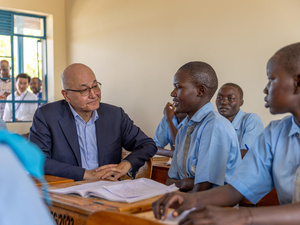Somali refugees in Ethiopia's Dollo Ado exceed 150,000 as rains hit camps
Somali refugees in Ethiopia's Dollo Ado exceed 150,000 as rains hit camps

A woman and young Somali refugees in the arid transit centre of Dollo Ado.
NAIROBI, Kenya, April 27 (UNHCR) - The UN refugee agency said Friday that heavy rains have hit Somali refugee camps in Ethiopia and Kenya, damaging tents, flooding roads and affecting aid delivery. This comes as the refugee population in southern Ethiopia swells to more than 150,000.
"In recent weeks, Dollo Ado in southern Ethiopia has been receiving a weekly average of 450 new Somali refugees. More than 8,500 have been registered so far this year, pushing the refugee population in the area's five camps past the 150,000 mark," said a UNHCR spokesman.
New arrivals continue to cite insecurity inside Somalia as their reason for flight. In a new development, some refugees say they fled in fear of possible forced recruitment or military conscription. Others cite fear of potential revenge killings in the wake of renewed fighting. These circumstances, combined with last year's famine in Somalia, eroded many people's traditional coping mechanisms and forced them to seek asylum across the border.
Meanwhile, heavy rains in mid-April damaged an estimated 700 tents in Dollo Ado. Prior to this, UNHCR staff had begun identifying refugees whose shelters would need reinforcement against the rain. They started distributing thousands of plastic sheets in the different camps two weeks ago, and are providing replacement tents to a smaller number of families whose shelters were destroyed by the wind and rain.
The access road to one of the camps, Hilaweyn, has been flooded. This has slowed down the delivery of services, including water provision. UNHCR has met partners to work on rehabilitating the road and maintaining access to the camp. Dollo Ado's dry-weather airstrip was closed for most of last week, but is currently serviceable. Road convoys are in place during the rainy season, to supplement or replace air travel as necessary.
In north-eastern Kenya, the Dadaab refugee complex has also been affected by the recent rains. Since mid-April, UNHCR has been distributing plastic sheets and tents to refugees whose shelter has been damaged or collapsed because of downpour.
"Our staff are standing by to distribute more tarpaulins and other relief items, prioritizing the most vulnerable refugees and those whose homes have been affected by the rains. UNHCR and our partners are also working to mitigate the effects of potential floods. Needs assessment and plans have been developed, but budgetary constraints are hindering progress," said the UNHCR spokesman, Adrian Edwards.
In anticipation of malaria cases, UNHCR's health partners have started distributing insecticide-treated mosquito nets. Some 220,000 nets will be handed out in the next four weeks in Dadaab's Ifo, Dagahaley and Hagadera camps, accompanied by demonstrations and information sessions on their use and care. The Dadaab refugee complex current hosts more than 460,000 refugees, the majority from Somalia.
Decades of conflict and drought have driven more than 980,000 Somali refugees into the region, most of them hosted in Kenya, Yemen and Ethiopia. Another 1.36 million Somalis are internally displaced within the country.
By Vivian Tan in Nairobi, Kenya







